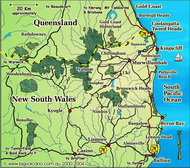Julian Rocks (Nguthungulli) Marine Reserve, Byron Bay NSW
27/8/21: Julian Rocks Marine Reserve was renamed Julian Rocks (Nguthungulli) Marine Reserve after a recommendation in the January 2011 Plan of Management.
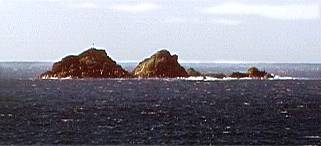
An Outstanding Marine Reserve Not To Be Missed
by Wandy Brouwer & Tim Hochgrebe, September 2000.
Underwater photography © Tim Hochgrebe.
According to a story from the Bundjalung people, a jealous husband threw his spear at the canoe of his wife and her lover.
The canoe broke in two and sank to the bottom of the ocean. Only the back and the front of the boat stuck out of the water, creating a rock formation 2.5 km off shore.
With the two main peaks named after his nephew and niece (Juan and Julia) by Captain Cook when he sailed by in 1776, Julian Rocks consists of ancient volcanic rock*, remains of an eruption more than 20 million years ago.
Photo above right: © Juan and Julia (Julian) Rocks
Established as a marine reserve in 1982 after 10 years of lobbying by local users, Julian Rocks is one of Australia's top dive spots, and forms a most unique marine reserve, providing shelter and food for more than 500 tropical and temperate fish species.
Not only does Julian Rocks provide resting and nesting grounds for many seabirds, such as seagulls and cormorants, underneath the water is an invisible world with abundant marine life present.
Grey nurse sharks
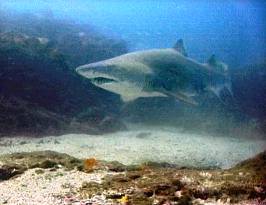
With water temperatures and currents changing throughout the year there are many seasonal visitors.
The grey nurse sharks come to Julian Rocks during the winter months, presumably to breed.
Although these sharks look ferocious with their mouths slightly opened and their teeth sticking out, it is perfectly safe to dive with them.
Photo right: © Grey nurse shark
Leopard sharks
In spring the blue tang pays Julian Rocks a visit. This is a fish which can be easily distinguished by its blue body and bright yellow tail. Schools of big-eye trevally are most common in summer.
The docile leopard sharks can be seen on almost every dive during mid-summer when the waters are warmest. The spotted patterns on their skin gives them their name. Most of the time they lie resting on the sand, but if you are lucky you can see them swimming, moving their long tail slowly.
Photo right: © Leopard shark
Manta rays
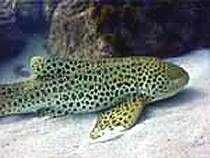 In summer and early autumn manta rays cruise elegantly through the waters
surrounding the rock. Sometimes feeding and definitely curious they
are fantastic to encounter.
In summer and early autumn manta rays cruise elegantly through the waters
surrounding the rock. Sometimes feeding and definitely curious they
are fantastic to encounter.
And then there are of course the ‘regulars’ like different species of wobbegong sharks, turtles, cuttlefish, schools of white spotted eagle rays, egg-cowry shells, moray eels, banner fish, giant guitar fish and shovel-nose rays.
Sometimes there are so many fish around, you can hardly see where you are going.
Underwater Garden
Not to mention all sessile animals (attached to substrate) like tunicates, colourful sponges, both hard and soft corals, giving you the feeling you are floating through some beautifully landscaped underwater garden.
The Rock also forms a home for rare species such as the leaf scorpion fish, the pineapple fish with bioluminescent organs under its eyes, the shy blue devil fish, white banded anemone fish and a species of nudibranch previously thought not present in Australian waters (Noumea labouti). (A nudibranch is a colourful underwater snail without a shell, carrying its respiratory organ on its back.)
Humpback Whale Migration
The interaction of tropical and temperate species makes every dive an exhilarating adventure. The three minute boat trip to the rock is almost as exciting: surfing the waves sometimes accompanied by playful dolphins.
From May till September the Humpback whales come past Byron Bay and can easily be spotted from the boat. With water temperatures up to 25 degrees Celsius and visibility of 20 meters at most times there is really nothing to complain about.
Valuable Aquatic Reserve
Fortunately the dive operators in Byron Bay also realise the value of this Aquatic Reserve. Moorings have been put in place and are taken care of, so destructive anchors are not needed.
And since there are only a limited number of commercial vessel launching licences available, no over-diving can take place.
All different dive sites around Julian Rocks are equally impressive and offer dives that are spectacular for the novice and the very experienced underwater explorer!
Wandy Brouwer & Tim Hochgrebe
About the Authors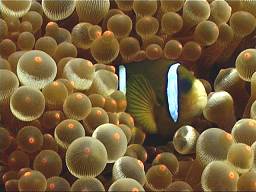
Photo right: © Clown fish
References and Readings
* Ancient Volcanic Rock; Described as Meta sediments of the Neranleigh-Fernvale beds, from; "Tweed Volcanic Region, 360 million years ago to the present day. An Environmental History of the Beaudesert, Gold Coast, Tweed, Brunswick and Richmond Region" v1, 2001. Compiled by (the late) Bruce Graham.
